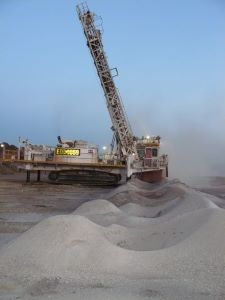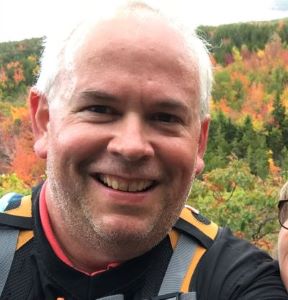Webinar Summary- Optimizing Fragmentation Using Measure While Drilling and 3D Analytics Data
Drilling data is a critical component of blast performance. Knowing the as-drilled positions of holes is key to optimizing energy distribution and preventing misfires from hole to hole interactions. Additionally, drilling provides important information on bench geology which should be used to tailor blast designs as well as blending plans and plant settings.
Traditionally, drilling data has been difficult to capture and combine with blast design information. Now, new technologies like 3D image analysis and Measure While Drilling(MWD) data allow blasters and site managers to "see" inside the bench in ways never before possible.
Better Drilling.
"See" the geology inside the bench and be prepared for the unexpected. Improve drilling performance on the fly. Make adjustments to the blast plans and let the blasters know exactly what they're shooting.
Better Blasting.
Blast with confidence. Know where your "as drilled holes" are so you can get your true burdens, not just what they should have been. "See" inside the bench with Measure While Drilling data so you can tailor your loading to the bench's geology.
Better Results.
Get faster more efficient drilling. Optimize fragmentation, blending and plant performance. Reduce fly rock incidents. Control ore body movement. Reduce vibration. Leave behind safer bench faces.
Drilling expert Gus Diehr (Treasurer & Senior Drilling Manager, General Drilling) discusses new technologies available to optimize drilling and blast performance.
? How to Improve Fragmentation with differential energy loading
? How to Reduce flyrock with True Burden data
? How to improve drilling on the fly
? How to adjust drill plans in real time to achieve blast objectives
? How to reduce blasting impacts with MWD data including bench damage and vibration
Read on for a summary of the webinar... If you would rather watch the webinar click here.
To download a copy of the Presentation slides click here.
Q&A
We'll start at the end...
Unfortunately we ran out of time before we were able to answer everyone's questions. So, as promised, here are the answer to the questions asked during the webinar...
1. What MWD categories do you select to identify geological characteristics such as: broken material at top, cracks/seams/voids that could influence loading? Is it possible to identify hole wander?
Typically the MWD recording device has a place where the driller can manually pre-record typical geological characteristics such as Collar-voids-water-seams etc. In addition the actual data can record when changes take place. These changes are typically site based. Drills can record multiple items, what this data means is best determined by site experience. One site might prefer Penetration Rate, another might prefer Rotation Pressure.
Projected hole deviation will be captured in MWD data based on the collar GPS, setup position and length drilled. For the most accurate capture of hole wander, boretracking data can be uploaded and combined with MWD data.
2. How do you take block model information into account while designing the drill pattern?
Block model files in DXF format can be uploaded to Strayos and then you can incorporate that information for drill planning.
3. What can be done on a smaller project going into a new or unknown geology where the length of the time of overall project wouldn’t be as long? Like the rock hardness.
I would always err on the side of caution. “Green field” sites are tricky as the site geology is unknown. My preference is penetration rate and flushing pressure. This helps ID voids and soft/hard seams wear explosive energy can “leak.”
4. How do you decide on the most suitable drilling equipment for a given geo-mining condition?
- Production desired - tons or cubic meters
- Processing equipment optimal size
- Hole size based upon explosive use
- Drill size and type
5. I was surprised to see "powder factor" used as often as you did. I thought the trend was not to use or depend on that factor as much these days?
Powder Factor was referenced many times because it is one of the key drivers of economics for Blasting operations, it is a strong determinant of the cost to fragment a ton of the ore. For total site optimisation costs must be balanced with performance.
There are many other geospatial, geological, design and QAQC data points that are critical to use for predicting performance which should be included alongside Powder Factor in a site simulation/optimization model.
6. How do you keep drill chippings out of the hole after drilling?
We remove the “chippings,” “cuttings,” or the waste product created from drilling the hole while it’s being drilled. This is done via air pressure and the use of cyclone - diverter box.
Mike Martin, PR Polymers, Pty Ltd adds:
We are using a static chip deflector system under the drill - Please see a photo of resultant cutting piles and the shape of the ‘turkeys nest’ at BHP, Blackwater coal mine in Australia. Reduced fall back makes the drilled hole depth more accurate to the design. Deep angled holes can have up to 4m of unwanted cuttings at the toe, ready to ‘suck’ valuable VOD from the initiation system, leaving hard toe to deal with and an uneven bench for the next drill platform.

7. Where can you get MWD hardware from?
Sandvik, Epiroc, Komatsu, Caterpillar can supply this hardware with their drills. There are also aftermarket providers like LIM, Thunderbird, Flanders.
8. Did you measure the real path of each borehole or only the collar and the end?
For angle and azimuth the drills only measure the first couple of seconds on the hole. The bottom of the hole is calculated assuming a straight line from the start. Hole deviation is not yet being measured while drilling. It can be measured after drilling using a hole deviation tool like a Boretrak.
9. Years ago we tried to implement or introduce the old analog drill parameter recorders from France on our drill rigs for geotechnical site investigations. We met not only lots of resistance but even sabotage. What has been your experience with this new MWD equipment and working or tactics to get the driller, old and new, to cooperate? My question or experience is from the non-private site of drilling.
People are very hesitant to change. We have experienced this as well. Fortunately, new MWD and Smart Drill systems are designed to make life easier for the operator which helps with gaining buy in. The systems are there to help with everyone's common goal of drilling better holes rather than tracking each driller Big Brother style. Additionally, much of the data capture is automated and so is not subject to sabotage or manual entry errors.
10. How does MWD consider lithology? Is it through PR values? If so, then can it also indicate which rock it is?
It cannot ID the type of rock. It can tell you where the rock characteristics change from second to the next. Using this change you can infer based upon site geology what the rock lithology is doing. Here AI and machine learning can be very useful when MWD data is collected for each shot to draw a correlation about lithology from historical shots.
11. What's the accuracy of the GPS you are proposing?
CM or survey grade accuracy in X,Y, and Z (Lat/Long/Elevation)
12. What, if anything, are you looking to add to this technology? For example, geophysics, or maybe a place where we could share data.
Yes, any additional data from sensors and geophysics info are always helpful and it provides unique insights along with the MWD information. Strayos offers a range of other tools that complement the MWD data. Additionally, Strayos is a cloud based platform which allows users to host, integrate, and share any type of geospatial and geophysics data they have with their team members.
13. How do you simulate airborne data to achieve desired goals?
Airborne data can be used to generate 3D photogrammetry models that can be applied for different types of purposes such as measurements, surveying, design, and planning.
14. How do you measure fragmentation?
Strayos applies state of the art proprietary AI modelling techniques on 3D photogrammetry models to detect the muckpile boundary and the edges of the rock automatically. Then it applies an algorithm on the detected rock edges to calculate the sieve size for overall fragmentation measurement.
15. How do you connect fragmentation with the digging rate of the loading unit?
Our platform can take in machine data from loaders/shovels etc. to calculate measures like Instantaneous Dig Rate across each shot and compare it with our auto-detected fragmentation distributions. If loading equipment has GPS enabled, we can visualise color-coded digging rates over the 3D muckpile and correlate this with fragmentation at each exact location.
16. Is your hardware kit compatible with all types of drill rigs?
Strayos provides software that is compatible with any kind of hardware and aftermarket drill logging hardware. If you need specific info about hardware kits please email us and we will be happy to provide you more information.
17. Does your cloud based technology have the ability to measure hole volume?
Strayos provides automated measurement of hole volumes using an AI-powered geospatial algorithm combined with 3D drone model data. You can read more about it here:Strayos Hole Calculation
Poll Questions

Speaker
Gus Diehr
Treasurer and Senior Drilling Manager at General Drilling, Inc.

Gus has worked in the mining and quarry industry his entire life. He started in the blast hole drilling industry in highschool and worked summers drilling while he attended Hannover College. After graduating he continued as a driller eventually becoming Treasurer at General Drilling, Inc. Now he uses his drilling experience and expertise as needed for special or particularly challenging drill projects for General Drilling.

New technologies are rapidly changing the drilling, blasting, mining, and aggregates industries, empowering them in ways never before possible. Make sure you are taking advantage of the best tools available.
Check out our 2 Free E-books on AI applications for the drilling, blasting, and mining industries to see all the amazing advances that are available.
AI Guide for Drilling and Blasting
AI Guide for Mining
TLDR? Watch our videos instead:
YouTube
